
 Anthony
Colin Bruce Chapman – it is his initials which form part of the Lotus badge
built and raced cars from 1948 onwards, 40 years ago, he was very much
the innovative engineer, designing from first principles and, to a large
extent, re-writing the rulebook. His success in innovation produced a string
of ‘first"; in strut suspension, in construction and in Active
Suspension. The first ground effect car was a Lotus and so was the first
twin chassis car. His career was to be one that challenged traditional
engineering practice and won through.
Anthony
Colin Bruce Chapman – it is his initials which form part of the Lotus badge
built and raced cars from 1948 onwards, 40 years ago, he was very much
the innovative engineer, designing from first principles and, to a large
extent, re-writing the rulebook. His success in innovation produced a string
of ‘first"; in strut suspension, in construction and in Active
Suspension. The first ground effect car was a Lotus and so was the first
twin chassis car. His career was to be one that challenged traditional
engineering practice and won through.
The early years saw Chapman producing replicas of his early models at a workshop in north London. Later, his cars virtually monopolised their class in the classic 24-hour rave at le Mans. By the mid sixties, the Indianapolis 500 had become the richest prize to fall to Lotus, ushering in the innovative Lotus Turbine cars.
On the production side, 1957 saw the introduction of the original Lotus Elite, the first closed passenger car to carry the Lotus badge and the first ever car of monocque composite construction. Still regarded as one of the most beautiful cars ever built, the Elite was followed in 1962 by the Lotus Elan, a car that became a legend in its own time.

At Monaco, Lotus cars emerged victorious in 1960 and 1961, their first Grand Prix wins. And in 1961 Stirling Moss won the German Grand Prix in a Lotus: winning was getting to be a habit.
 .
. .
.